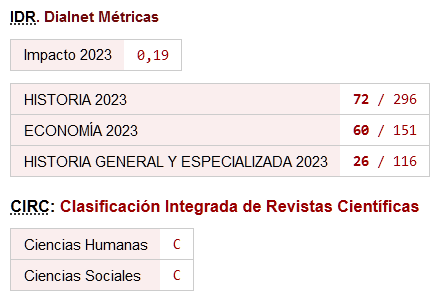Revisiting the boundaries of the sacred
guilds and brotherhoods’ accounting in the last decade of the 16th century
DOI:
https://doi.org/10.26784/issn.1886-1881.v18i1.415Palabras clave:
Accounting history, Religious organisations, 16th century, Accountability, Accounting awareness, GuildsResumen
This work questions whether religious organisations, whose members have common shared beliefs and sacred objectives but different levels of accounting awareness, behaved differently depending on their awareness to accounting techniques.
To this aim, we have analysed the content of six rules of brotherhoods founded in the city of Seville (Spain) during the last decade of the 16th century. We have grouped the brotherhoods according to their being (or not) linked to a guild or professional group.
We can conclude that their members’ familiarity with accounting, or lack thereof, can explain the dissimilar behaviour of brotherhoods in relation to accounting, but not to accountability.
Descargas
Citas
Alvarez-Dardet C López Manjón JD and Baños J (2006) Accounting at the boundaries of the sacred: The regulations of the Spanish brotherhoods in the eighteenth century. Accounting History, 11(2): 129-150. https://doi.org/10.1177/1032373206063110
Arias de Saavedra Alias I and López-Guadalupe Muñoz ML (2002) La represión de la religiosidad popular: crítica y acción contra las cofradías en la España del siglo XVIII. Granada: Universidad de Granada.
Ballarín Garnica Á (2014) Detección de indicios de manipulación contable y posible práctica "fraudulenta" en el gremio del comercio textil de Londres en los siglos XIV y XV. Pecunia: Revista de la Facultad de Ciencias Económicas y Empresariales, (19): 21-42. https://doi.org/10.18002/pec.v0i19.3580
Baños J and Funnell W (2015) War or the business of God: Sacred mission, accounting and Spanish military hospitals in the 18th century. Accounting, Auditing & Accountability Journal, 28 (3): 434-459. https://doi.org/10.1108/AAAJ-01-2014-1588
Baños J and Carrasco F (2019) Institutional entrepreneurship in a religious order: The 1741 Constituciones of the Hospitaller Order of Saint John of God. Accounting History, 24 (2): 167-184. https://doi.org/10.1177/1032373218802858
Bernal A Collantes de Terán Sánchez A and García-Baquero González A (2008) Sevilla, de los gremios a la industrialización. Sevilla: Ayuntamiento de Sevilla, Instituto de la Cultura y las Artes de Sevilla.
Bigoni M Deidda E Funnell W (2013) Rethinking the sacred and secular divide: Accounting and accountability practices in the Diocese of Ferrara (1431-1457). Accounting, Auditing & Accountability. https://doi.org/10.1108/09513571311327462
Journal, 26 (4): 567-594. https://doi.org/10.1108/09513571311327462. https://doi.org/10.1108/09513571311327462
Booth P (1993) Accounting in Churches: A research framework and agenda. Accounting, Auditing & Accountability Journal, 6 (4): 37-67. https://doi.org/10.1108/09513579310045684
Bowrin A (2004) Internal control in Trinidad and Tobago religious organizations. Accounting, Auditing & Accountability Journal, 17 (1): 121-152.https://doi.org/10.1108/09513570410525238
Carmona S and Ezzamel M (2006) Accounting and religion: A historical perspective. Accounting History, 11 (2): 117-127. https://doi.org/10.1177/1032373206063109
Cordery C (2015) Accounting history and religion: A review of studies and a research agenda Accounting History,20 (4):430-463. https://doi.org/10.1177/1032373215610590
Donoso R (1996) Una contribución a la historia de la contabilidad. Análisis de las prácticas contables desarrolladas por la Tesorería de la Casa de la Contratación de Indias de Sevilla (1503, 1717). Sevilla: Universidad de Sevilla.
Donoso R (2001) Algunos aspectos relacionados con el control administrativo y contable de la renta de los esclavos enviados a Hispanoamérica (hasta el final del periodo de las licencias en 1595). Revista Española de Financiación y Contabilidad, 110: 1093-1135. https://www.jstor.org/stable/42781440.
Ezzamel M (2005) Accounting for the activities of funerary temples: The intertwining of the sacred and the profane. Accounting and Business Research, 35 (1): 29-51. https://doi.org/10.1080/00014788.2005.9729661
Fonfeder R Holtzman MP and Maccarrone E (2003) Internal controls in the Talmud: The Jerusalem temple. The Accounting Historians Journal, 30 (1): 73-93. https://doi.org/10.2308/0148-4184.30.1.73
Funnell W Williams R (2014) The religious imperative of cost accounting in the early industrial revolution. https://doi.org/10.1108/AAAJ-03-2013-1269
Accounting, Auditing, & Accountability Journal, 27 (2): 357-381. https://doi.org/10.1108/AAAJ-03-2013-1269. https://doi.org/10.1108/AAAJ-03-2013-1269
García Martí JH and Martínez Soto S (2015) La contabilidad de la Real e Ilustre Cofradía de Nuestro Padre Jesús Nazareno de Cartagena durante el segundo tercio del siglo XX. De Computis: Revista Española de Historia de la Contabilidad, 23: 92-109. https://doi.org/10.26784/issn.1886-1881.v12i23.20
González Arce JD (2008) Las cofradías del mar en la Corona de Aragón (siglos XIII-XV). Espacio, Tiempo y Forma. Serie III, Historia Medieval, (21): 285-310. https://doi.org/10.5944/etfiii.21.2008.3792
Hernández E (1992) Orígenes y desarrollo de la contabilidad en España (siglos XIII-XIX). In Gonzalo JA (coord.) Contabilidad en España, 1992. Madrid: ICAC.
Irvine H (2002) The legitimising power of financial statements in the Salvation Army in England. The Accounting Historians Journal, 29 (1): 1-36. https://www.jstor.org/stable/40698259. https://doi.org/10.2308/0148-4184.29.1.1
Irvine H (2005) Balancing money and mission in a local church budget. Accounting, Auditing & Accountability Journal, 18 (2): 211-237. https://doi.org/10.1108/09513570510588733
Jacobs K (2005) The sacred and the secular: examining the role of accounting in the religious context. https://doi.org/10.1108/09513570510588724
Accounting, Auditing & Accountability Journal, 18 (2): 189-210. https://doi.org/10.1108/09513570510588724
Jacobs K and Walker SP (2004) Accounting and accountability in the Iona Community. Accounting, Auditing & Accountability Journal, 17 (3): 361-381. https://doi.org/10.1108/09513570410545786
Laughlin R (1988) Accounting in its social context. An analysis of the accounting systems of the Church of England. Accounting, Auditing & Accountability Journal, 1 (2): 19-42. https://doi.org/10.1108/EUM0000000004622
Lightbody M (2000) Storing and shielding: Financial management in a church organization. Accounting, Auditing & Accountability Journal, 13 (2): 156-174. https://doi.org/10.1108/09513570010323245
Lightbody M (2003) On being a financial manager in a church organisation: understanding the experience. Financial Accountability & Management, 19 (2): 117-138. https://doi.org/10.1111/1468-0408.00166
Maté L Prieto MB and Tua Pereda J (2004) La actividad financiera del Monasterio de Silos a la luz de sus libros de cuentas. De Computis, Revista Española de Historia de la Contabilidad, Spanish Journal of Accounting History, 1: 97-141. https://doi.org/10.26784/issn.1886-1881.v1i1.242
McPhail K Gorringe T and Gray R (2005) Crossing the great divide: critiquing the sacred secular dichotomy in accounting research. Accounting, Auditing & Accountability Journal, 18 (2): 185-188. https://doi.org/10.1108/09513570510588715
Moggi S Filippi V Leardini C and Rossi G (2016) Accountability for a place in heaven: A stakeholders' portrait in Verona's confraternities. Accounting History, 21 (2-3): 236-262. https://doi.org/10.1177/1032373216643078
Napier C (1989) Research directions in accounting history. The British Accounting Review, 21 (3): 237-254. https://doi.org/10.1016/0890-8389(89)90095-4
Navarro Espinach G (2015) Corporaciones de oficios y desarrollo económico en la Corona de Aragón, 1350-1550. Areas, Revista Internacional de Ciencias Sociales, 34: 21-31.
Parker LD (2001) Reactive planning in a Christian bureaucracy. Management Accounting Research, 12 (12): 321-356. https://doi.org/10.1006/mare.2001.0165
Quattrone P (2004) Accounting for God: Accounting and accountability practices in the Society of Jesus, Italy 16th-17th centuries. Accounting, Organizations and Society, 29 (7): 647-683. https://doi.org/10.1016/j.aos.2004.03.001
Reglá J and Céspedes J (1974): Imperio, absolutismo, aristocracia, Vol. IV. In Vicens, J. (Dir.) Historia social y económica de España y América. Barcelona: Editorial Vicens-Vives.
Romeu A (1981) Historia de la previsión social en España. Barcelona: Ediciones El Albir.
Sánchez J (1985) Las cofradías sevillanas: los comienzos. In VVAA, Las cofradías de Sevilla. Historia, antropología, arte. Sevilla: Servicio de Publicaciones de la Universidad de Sevilla y del Ayuntamiento de Sevilla.
Sánchez J and Pérez JM (2002) CXIX reglas de hermandades y cofradías andaluzas: siglos XIV, XV y XVI. Huelva: Universidad de Huelva.
Descargas
Publicado
Cómo citar
Número
Sección
Licencia

Esta obra está bajo una licencia internacional Creative Commons Atribución-NoComercial-CompartirIgual 4.0.










